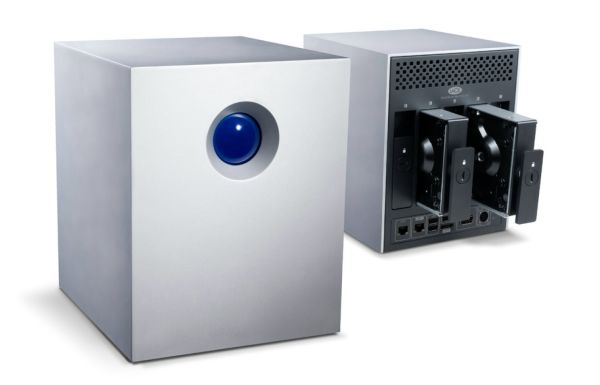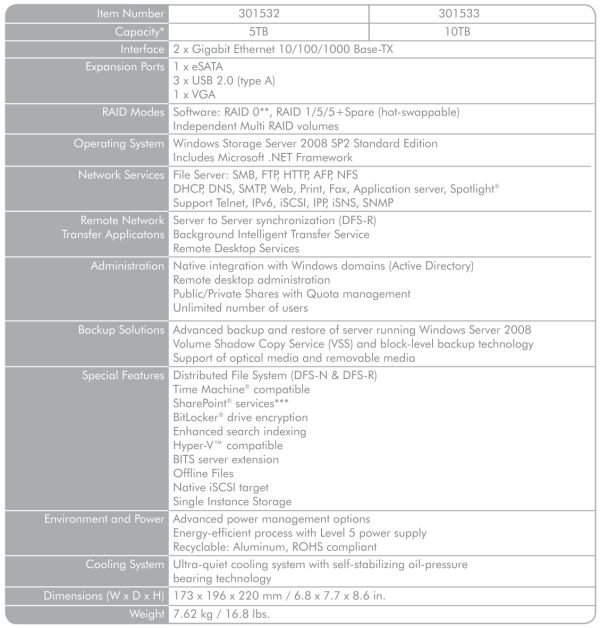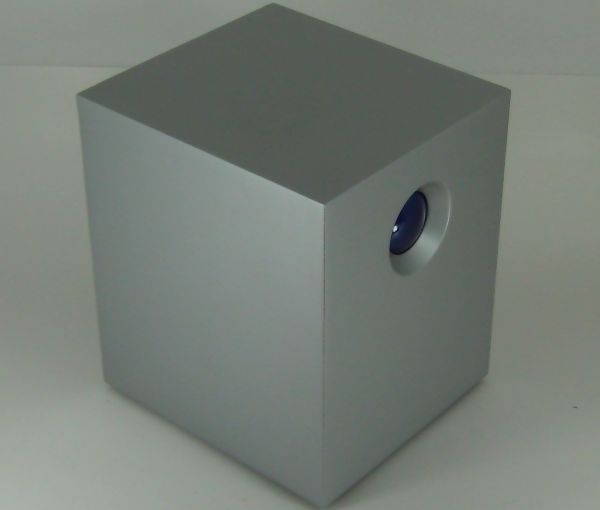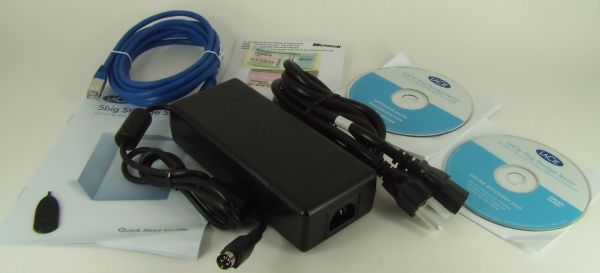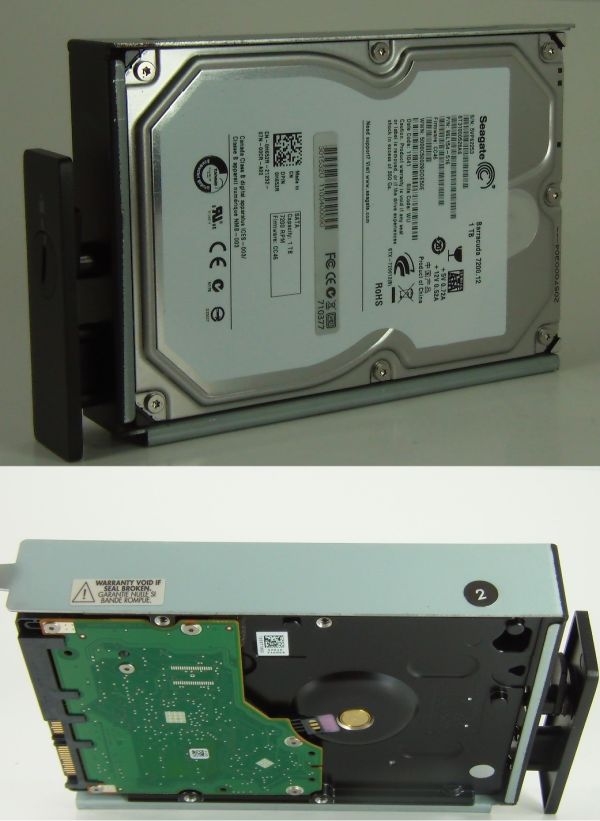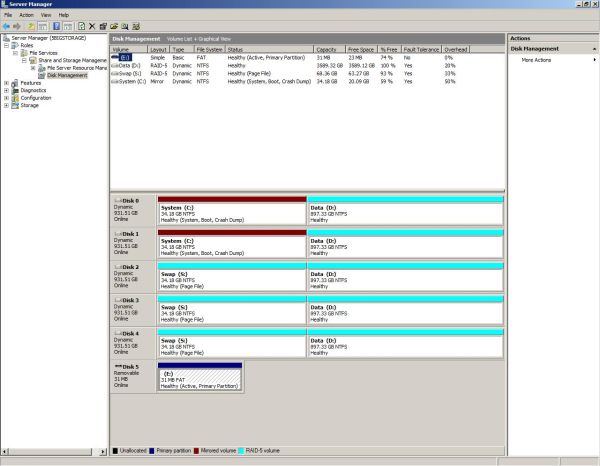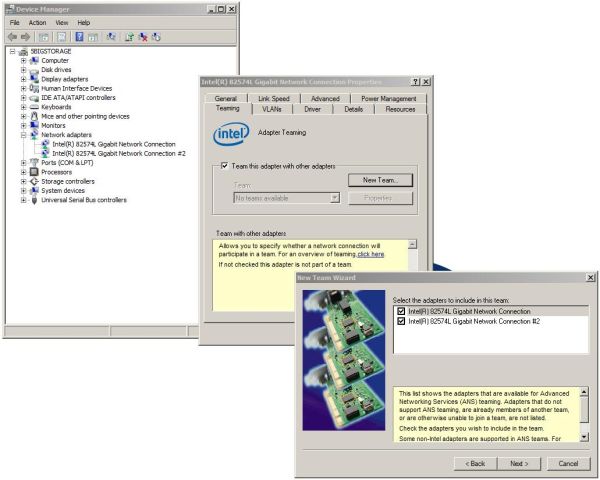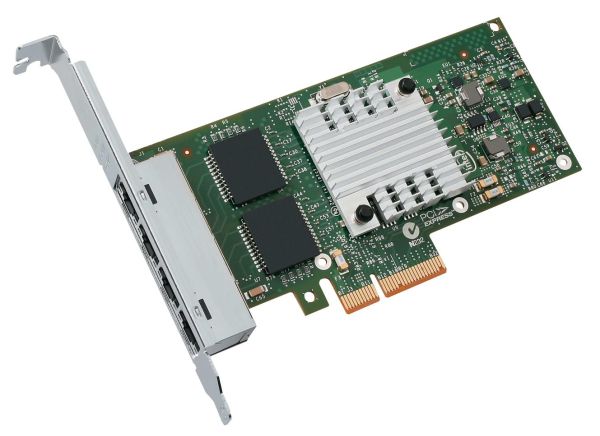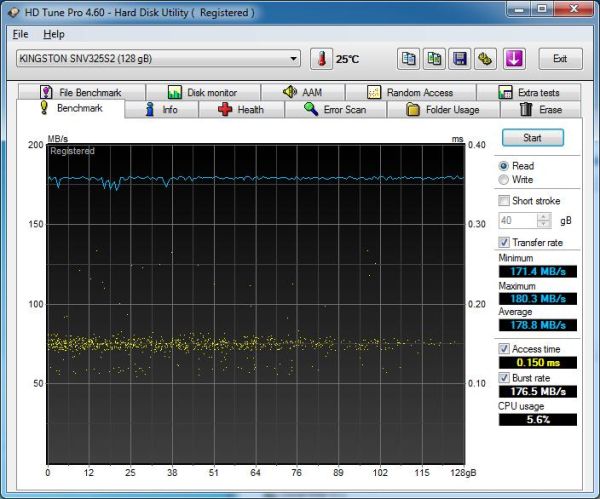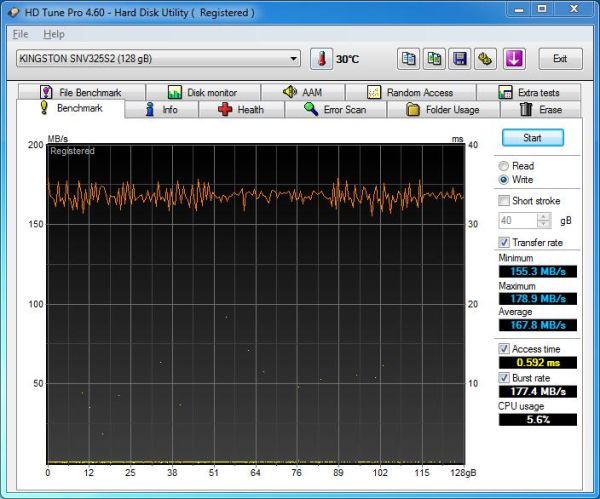
Original Link: https://www.anandtech.com/show/3996/lacie-5big-storage-server-nas-review
LaCie 5big Storage Server NAS Review
by Ganesh T S on November 8, 2010 9:26 PM EST- Posted in
- NAS
- LaCie
- 5big
- storage server
- Windows Storage Server
Back in March 2010, Intel announced an Atom based platform optimized for storage applications. Using either a D410 or the dual core D510, paired with an Intel 82801IR I/O controller, it was touted by Intel to have been picked up by various NAS vendors such as LaCie, LG, QNAP, Synology and Thecus. We have had the LaCie 5big storage server in our labs for the last few weeks. Aimed at catering to the needs of small and medium businesses for a professional file sharing appliance, the server brings in a wealth of features thanks to the Windows Storage Server 2008 platform on which the NAS runs.
The LaCie 5big storage server runs a dual core Atom D510 at 1.66 GHz with 2 GB of RAM. The Atom processor also handles the RAID management. While the RAID configuration can be changed by the end-user, it ships with the disks in RAID5. Thus, the 5big with 5 1TB hard drives has 3.5 TB of available space for data (after 100 GB is allocated for the OS installation and swap space).
The 5big storage server comes in two capacities, one filled with 1 TB drives and the other filled with 2 TB drives. Dual GbE NICs capable of link aggregation make sure that the performance of the NAS is no slouch. Let us wrap up this section with a brief look at the marketing specs from LaCie:
The NAS package was quite spartan. The contents of the box included the following:
- LaCie 5big storage server
- Cat 5E Ethernet cable
- 150 W external power supply
- DVD / CDs for server restore / miscellaneous software
- Getting Started guide
- Drawer key to lock / remove the storage drives
The storage server unit weighed in around 8 Kg, but was surprisingly diminutive considering that it packaged 5 3.5" hard drives inside. LaCie has always been known for its excellent industrial design, and the 5big storage server is no exception. It is beautiful to look at, but we all know that in the NAS area (particularly in professional file sharing appliances), looks are never the factor in a purchase decision.
The blue LED lamp up front seemed a touch annoying in the beginning, but its brightness could be controlled from within the OS. It also doubles up as a switch to power up the appliance. Thankfully, it is recessed to ensure that the unit is not accidentally switched off.
Considering that the NAS comes with dual GbE NICs, it would have been nice if LaCie had packaged in 2 Cat 5E cables instead of just one. The diminutive size of the appliance is enabled by going in for an external PSU. This is one of the bulkier power supplies you are likely to encounter, rated at 150 W.
The Quick Start Guide provided by LaCie is good enough for a company without dedicated IT staff to get the unit up and running. However, Windows Storage Server 2008 has a lot of features. End users who are not familiar with NAS units are likely to get overwhelmed. Though LaCie does carry some technical briefs to set up RAID configurations and NFS / SMB / AFP shares, we would have preferred a FAQ to be created. We encountered quite a number of issues which weren't covered in the technical briefs, particularly for iSCSI setup.
Our review unit had 5 Seagate Barracuda 7200 rpm 1 TB drives bundled inside. Our understanding is that Seagate drives are not exclusive for the 5big server, as we have seen some units with Samsung drives inside them.
As can be seen in the above picture, the drives are not user replaceable without voiding the warranty. Considering the premium that LaCie demands for these standard 1 TB drives, we found the restriction a bit harsh. However, LaCie offered us the reasoning that they wouldn't want to service a unit with some drives not officially sanctioned by them.
As mentioned in the previous section, the 5TB version of the NAS has around 3.5 TB space for data. The Server Manager program can be used as a one-stop shop for all the management tasks. The disk management snap-in shows how the disks are partitioned in the default setting.
The Hardware Monitor program serves as a way to adjust the fan, LED and power management settings.
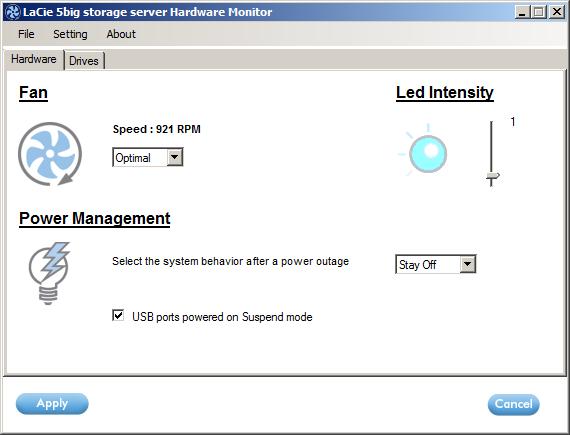
Dynamic link aggregation (IEEE 802.3ad) is one of the advertised features of the 5big storage server. It was quite simple to set it up from the Device Manager console, as shown in the pictures below. Dynamic link aggregation allows us to view the 2 GbE NICs as a unified 2 Gbps link.
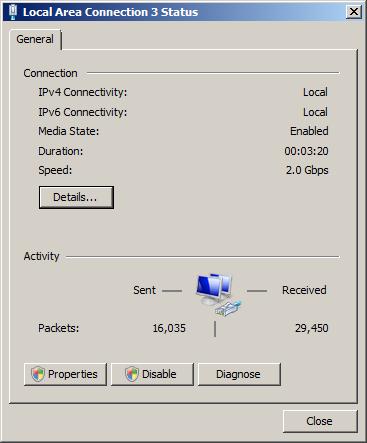
In the next section, we will explain our testing methodology and how the testbed setup gets connected to the 5big storage server configured as above.
For the purpose of NAS reviews, we have setup a dedicated testbed with the configuration as below. The NAS is directly connected to the testbed (using as many Cat 5E cables as there are ports on the NAS) without a switch or router inbetween. This is done in order to minimize the number of external factors which might influence the performance of the system.
| NAS Benchmarking Testbed Setup | |
| Processor | Intel i5-680 CPU - 3.60GHz, 4MB Cache |
| Motherboard | Asus P7H55D-M EVO |
| OS Hard Drive | Seagate Barracuda XT 2 TB |
| Secondary Drive | Kingston SSDNow 128GB |
| Memory | G.SKILL ECO Series 2GB (1 x 2GB) SDRAM DDR3 1333 (PC3 10666) F3-10666CL7D-4GBECO CAS 7-7-7-21 |
| PCI-E Slot | Quad-Port GbE Intel ESA-I340 |
| Optical Drives | ASUS 8X Blu-ray Drive Model BC-08B1ST |
| Case | Antec VERIS Fusion Remote Max |
| Power Supply | Antec TruePower New TP-550 550W |
| Operating System | Windows 7 Ultimate x64 |
| . | |
In addition to the Realtek GbE NIC on-board the Asus P7H55D-M EVO, four more GbE ports are enabled on the system, thanks to the Intel ESA-I340 quad port GbE ethernet server adapter . With a PCI-E x4 connector, the card was plugged into the PCI-E x16 slot on the Asus motherboard.
Two of the four ports are teamed together as shown in the video below below during the benchmarking.
Intel NASPT is used to benchmark the NAS device. In order to ensure that the hard disk transfer rate is not a bottleneck, NASPT is run from the secondary drive in the testbed (the Kingston SSD). With average read and write speeds of 178.8 MB/s and 167.8 MB/s, it is unlikely that a single GbE link NAS can be limited in performance due to the test system. However, a link aggregated NAS could be affected. Fortunately, as we will see in the next few sections, this wasn't the case for the 5big storage server.
All file copy tests were also performed using the SSD. The file copy test consists of transferring a 10.7 GB Blu-Ray folder structure between the NAS and the testbed using the robocopy command in mirror mode.
There are three important sharing protocols we investigated in the course of our evaluation of the 5big storage server. In the next few sections, you will find NASPT / robocopy benchmarking results for Samba, NFS and iSCSI sharing protocols. Each section also has a small description of how the shares were set up on the NAS. The NASPT benchmarks were run in Batch mode thrice, giving us 15 distinct data points. The average of these 15 values is recorded in the graphs presented in the following sections. The robocopy benchmark was run thrice, and the average transfer rate of the three iterations is presented alongside the NASPT benchmarks.
Samba shares were the easiest to setup on the LaCie 5big storage server. The video below shows how we configured a SMB share on the NAS.
Running the Intel NASPT benchmark and the robocopy tests gave us the following results:
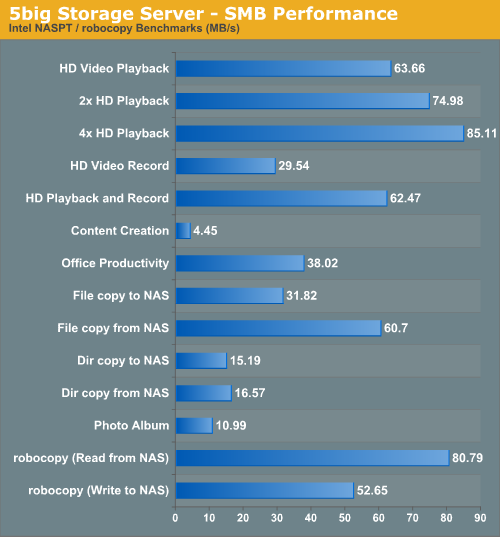
LaCie claims speeds upto 100 MB/s in their marketing literature. While we weren't able to achieve that much in our controlled testbed, we did reach speeds between 80 and 90 MB/s in some of our benchmark components.
NFS shares have a few more configuration options when compared with SMB shares. The following video shows how we set up a NFS share on the 5big storage server.
Running the Intel NASPT benchmark and the robocopy tests gave us the following results:

These results are abysmal, to say the least. With a 10x degradation in performance when compared with SMB shares, we initially suspected some issue with our client settings. However, the figures were reproducible across many Windows 7 machines. LaCie couldn't get back to us in time when contacted about this anomaly. Till we get to the root cause of this issue, our suggestion is to avoid NFS shares on the 5big storage server.
UPDATE: LaCie got back to us regarding the NFS performance and backed up the findings in the above benchmark graph. They indicated that NFS performance is managed by the OS (Windows Storage Server), and is not actually dependent on LaCie’s hardware. Our recommendation remains that the unit is not suitable for Linux workgroups, where NFS tends to be a better choice
Setting up iSCSI targets and making initiators connect to them is not as easy as setting up SMB shares. However, there is quite a bit of help available on the Internet. We followed two informative links (here and here).
The iSCSI target and a 500 GB virtual disk were created as shown in the video below.
On the testbed, the mapping of the created target was quite straightforward once the appropriate ports were opened up. The video below shows the relevant procedure:
Running the Intel NASPT benchmark and the robocopy tests gave us the following results:
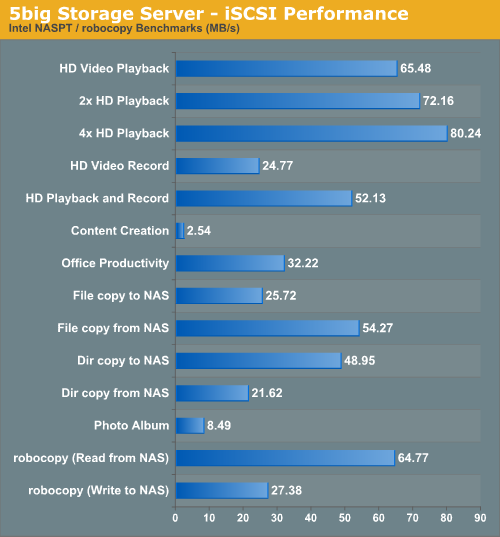
While iSCSI has the advantage of appearing as a fully local disk in the client, we find that its performance in terms of read and write speeds is not as much as what is obtained on SMB shares. However, there is not much difference between the iSCSI and SMB performance numbers.
Power consumption of the NAS is quite important, considering that the unit is likely to be permanently powered on. At power-off, just connecting the 150W adapter resulted in a power consumption of 2.2 W. When powered up and left idle, i.e, with inactive network interfaces, the unit consumed, on an average, around 46 W. At load, with multiple clients reading and writing to SMB shares on the NAS, the unit consumed a maximum of 58 W.
The Hardware Monitor program (which comes pre-installed on the server) can be used to monitor the health of the drives, including their temperatures. In the course of our testing, even an extremely high amount of traffic to the drives didn't cause the temperatures to rise beyond 45 C. At idle, the temperatures were in-between 35 and 39 C.
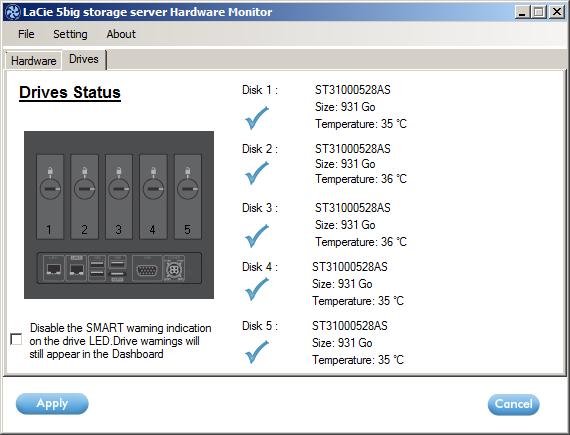
While the fan noise from the system is barely audible at 10 ft distance, the same can't be said of the hard drive noises in case of heavy traffic. Being a professional file sharing appliance meant for usage in business environments, this should definitely not be taken as a drawback for the system.
LaCie is well known for catering to the Apple ecosystem. The 5big storage server is no different. An OEM version of Group Logic's ExtremeZ-IP file and print server is supplied for upto 25 file and print users each. Instructions for setting up AFP shares are also available in the online technical briefs. The unit is also Apple Time Machine compatible.
We took a look at the performance of the LaCie 5big storage server. It lives up to most of the marketing claims made by LaCie. The system is a good choice if it is going to be primarily used in a Windows / MAC environment. The issues with NFS performance prevent us from recommending it for Linux workgroups.
The unit can currently be purchased from Newegg for $1475. Is it worth the cost? As small business owners and IT support staff often say, the money is not for the product alone, but for the quality, warranty and after-sales support. Unfortunately, our review can't evaluate the last two two metrics except to note that the unit we received has remained up and running without issues for the last four weeks.
The price is much higher than the previous generation model, but this can be explained by the added cost of the Windows Storage Server 2008 license, and the improved performance. This OS brings along with it a multitude of features (which we didn't get an opportunity to test out) such as Active Directory support, MS Bitlocker encryption and DFS (Distributed File Systems, making it ideal for branch offices). The unit also provides an eSATA extension port for attaching further storage. The USB ports can be used for attaching keyboards / mice and also for attaching additional storage.
With transfer rates of almost 90 MB/s, the 5big Storage Server is quite an effective NAS. LaCie seems to have built upon their experience in this space by taking care of all the shortcomings of their previous generation product. In the professional storage appliance space, there are factors beyond the actual performance which decide the success of the unit. That said, the LaCie 5big storage server has a solid foundation to build its reputation upon.

